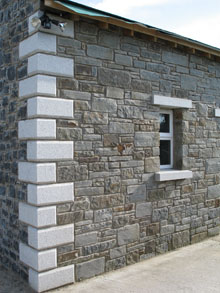Rivington Unitarian Chapel is an active place of worship and Grade II* listed buildingStructure of particular architectural and/or historic interest deserving of special protection. in RivingtonVillage in the Borough of Chorley, to the northwest of Bolton, on the fringe of the West Pennine Moors., Lancashire.[1] The stone chapel was built in 1703, but the congregation dates from 1662, when it separated from Rivington ChurchActive Anglican parish church and Grade II listed building in Rivington, Lancashire. The congregation is a member of the Manchester District Association of the General Assembly of Unitarian and Free Christian Churches.[2]
The chapel was built using local stone, and its restored interior contains the original box pewsType of church seating with enclosed sides. and a memorial to the Willoughbys of Parham, who supported its foundation. Presbyterianism gave way to the Unitarianism in the late 18th century.
Background
Between 1649 and 1660 Parliament dismantled the Church of England and the Presbyterian Church which was governed by non-hierarchical assemblies of clergy and lay elders was established. Worship was based on preaching from the Bible rather than the prayer book. After the return of Charles II, the Church of England was restored in 1662 but by then other religious movements had taken hold. Penal laws enacted in the 1660s and 1670s persecuted Catholics and Nonconformists unleashing violent religious disturbances. Holders of public office, peers, MPs, schoolmasters, clergy, students at Oxford and Cambridge had to swear an oath upholding the King as head of the Church of England or lost most of their civil rights. Attending Catholic or Nonconformist worship was illegal and punishable by fine or imprisonment.[3]
History
The chief inhabitants in Rivington remained Presbyterian after their minister, the Reverend Samuel Newton,[4] was ejected from the church. He returned after a short time and the congregation appears to have remained Nonconformist.[5] Other meeting places were also used, and Thomas Anderton of Great House gave £100 to endow a minister in 1693. The chapel, built in 1703, contains a monument to the Willoughbys of Parham, who supported its erection. By the late 18th century Presbyterianism had given way to the Unitarian doctrine.[6]
Structure
The chapel is a plain structure, built of gritstone with quoins
Any external angle or corner of a structure. at the corners and a slate roof. It has a small, hexagonal bellcote on the west gable. The side walls have two cross-windows with rectangular panes of glass and the gable walls have windows with small diamond-latticed panes of glass. On the south side are two doorways with chamfered surrounds; over one door is a lintel dated 1703. At the north-west corner is a two-storey wing with a tall chimney stack, which was the school house. The building is surrounded by a drystone wall and has cast iron gates.[3]
The ceiling is supported by oak beams; the walls are plain and lime washed. On the north wall between the windows is a raised, five-sided, panelled pulpit with a carved friezeHorizontal central band of an entablature, known as a pulvinated frieze if it has a convex profile. and moulded corniceHorizontal moulding crowning a building or part of a building, such as over a door or window, or at the junction of an interior wall and ceiling.. The chapel retains its box pews which were originally individually owned or rented. The Willoughby pew by the south wall has a large ornate canopy with panelled reredosLarge ornamented wall, screen, or other structure placed behind the altar in a Christian church. and a moulded and carved cornice in the classical style. The choir stall is at the east end.[3]
In the graveyard is the gravestone of one of the earliest textile factory builders, Samuel Oldknow “of Nottingham, late of Anderton” from 1759.[3] A plaque by the yew tree commemorates the American poet, Walt Whitman.[2]

